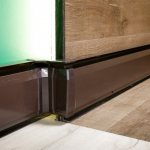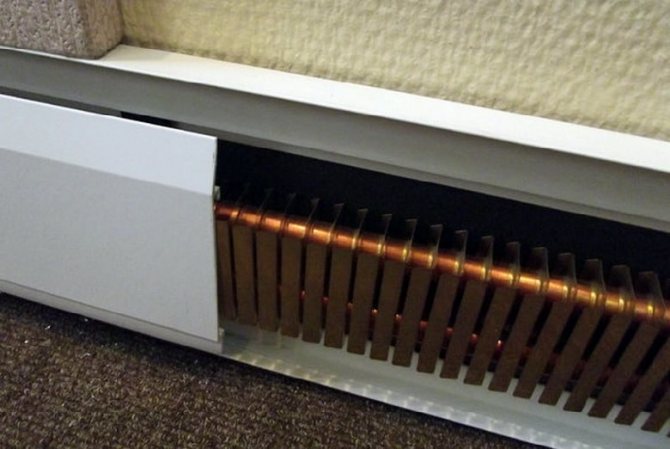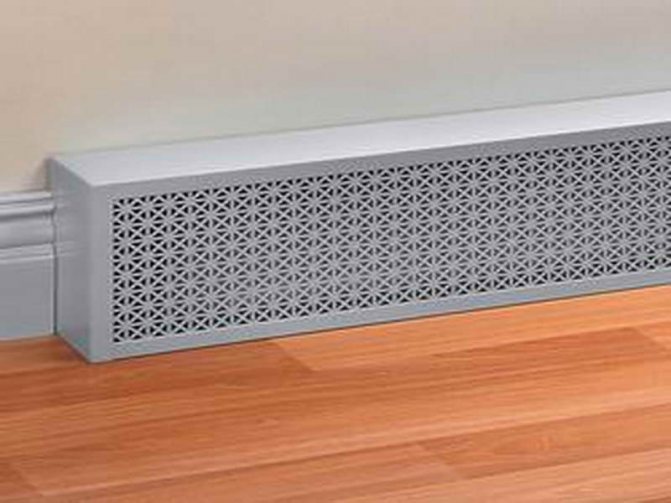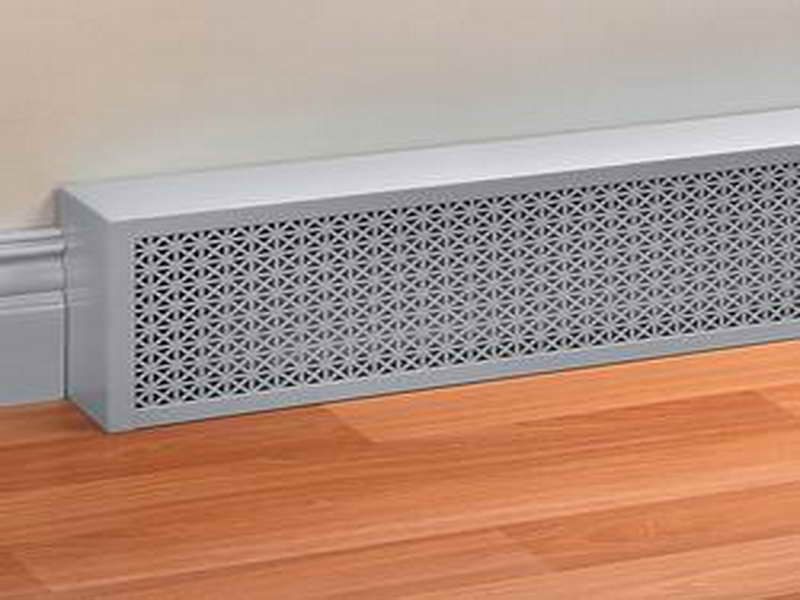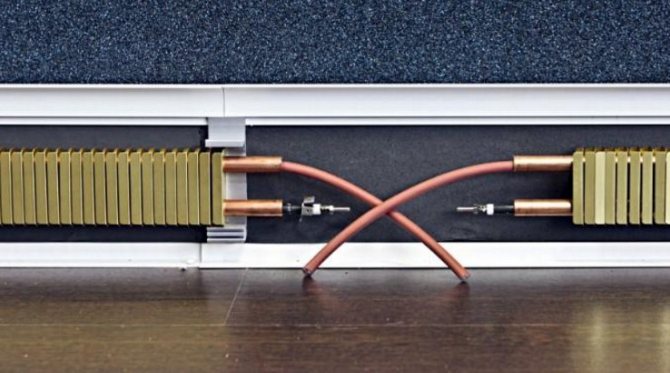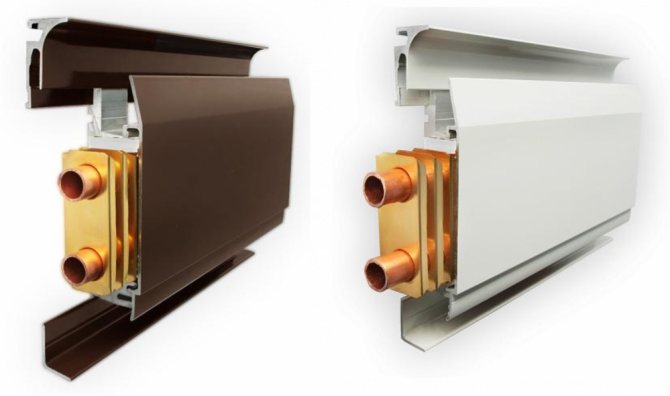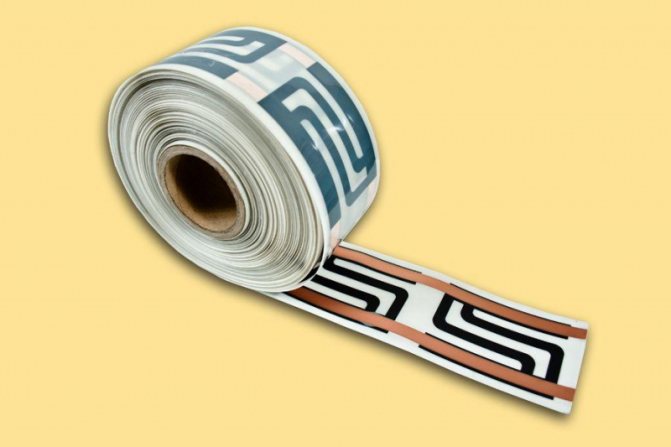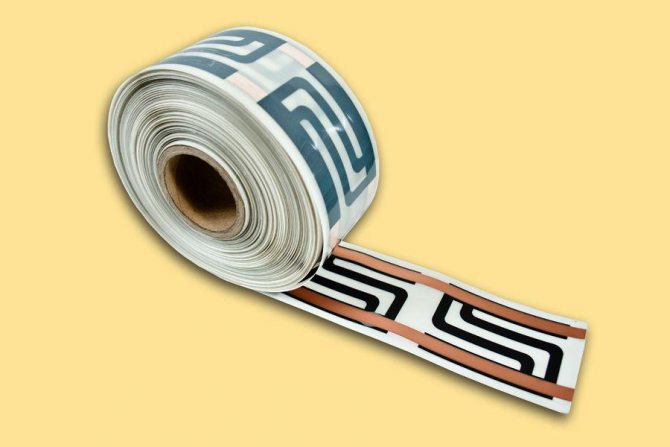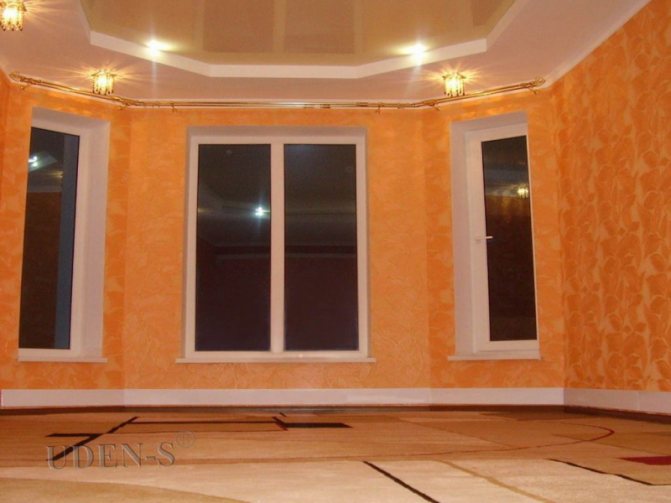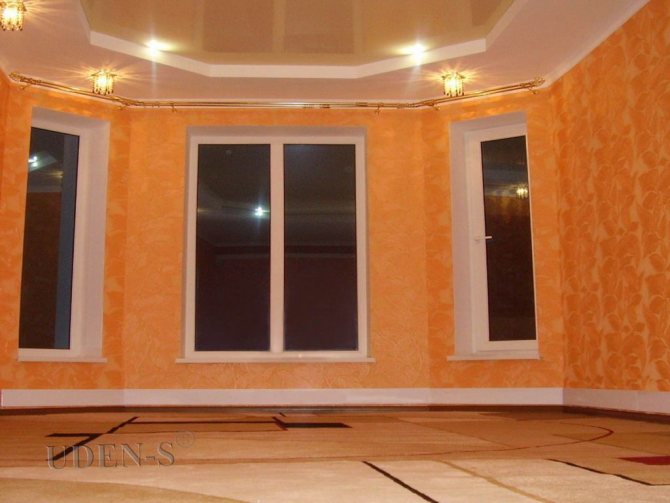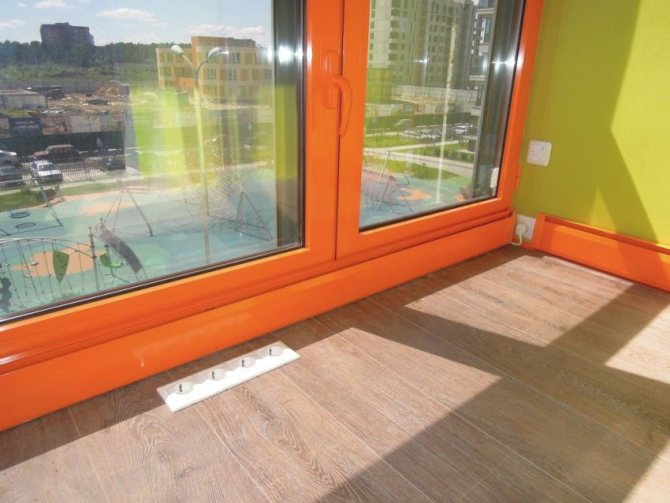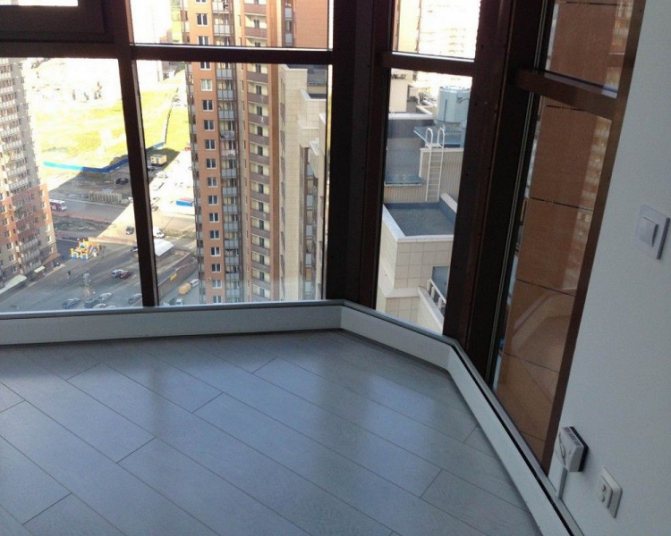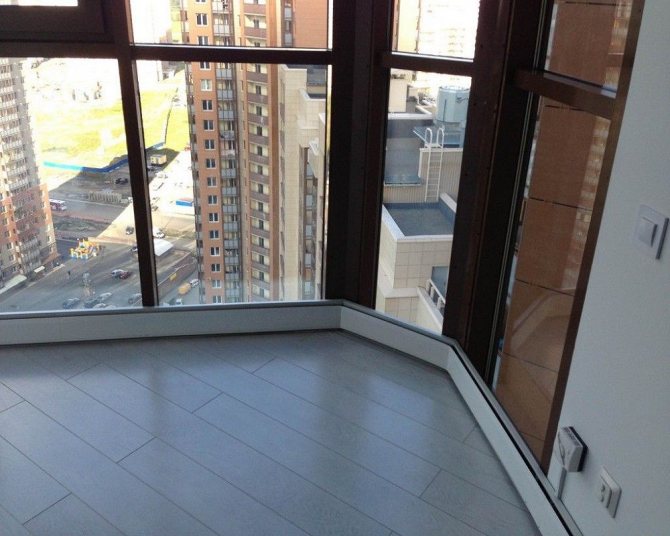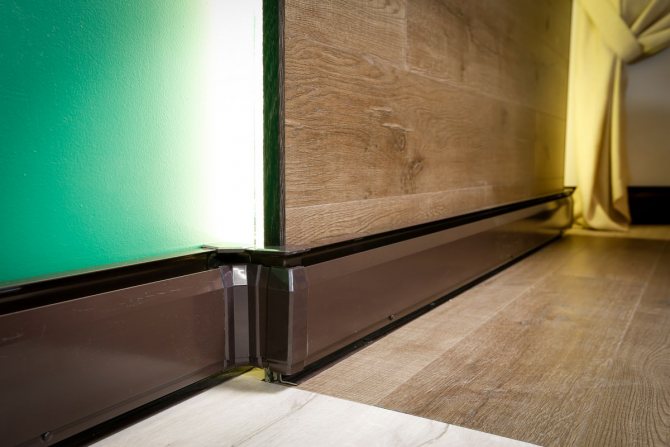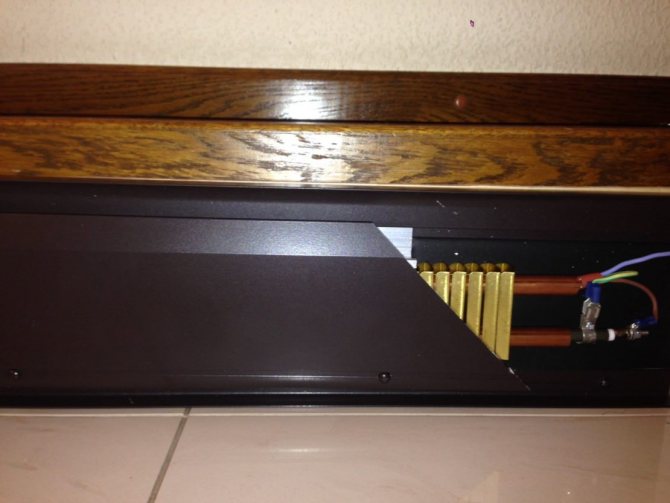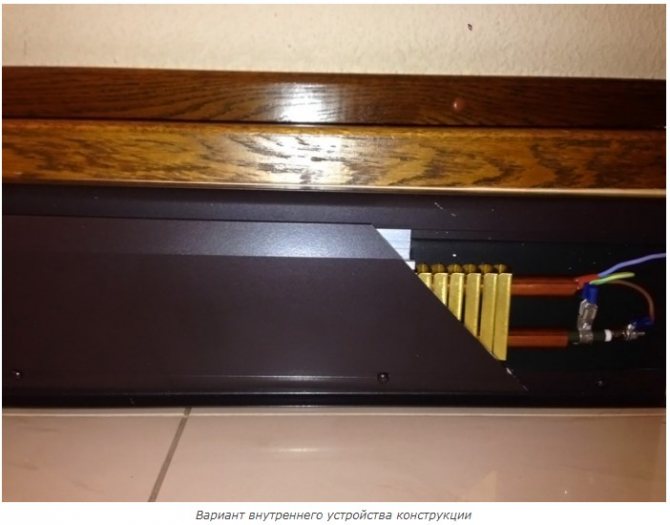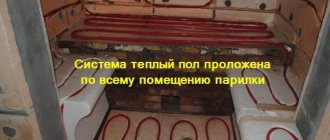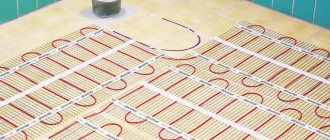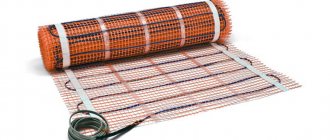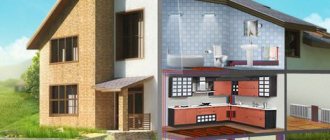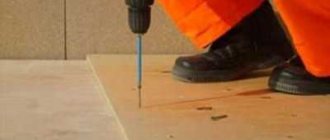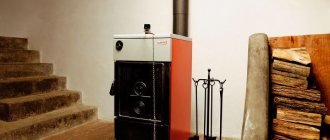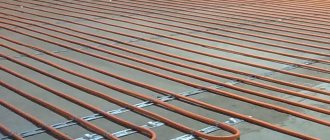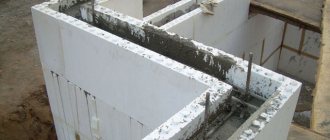SHARE ON SOCIAL MEDIA
FacebookTwitterOkGoogle + PinterestVk
In an effort to make your home cozier and more comfortable, we use a variety of new products. One of these innovations, which is actively used by lovers of modern interiors, is an electric warm skirting board. Due to the high thermal efficiency and economy of such heating, its use is fully justified. In this regard, we will consider the features of the installation, as well as the main advantages of warm skirting boards.
Electric warm skirting board is used for space heating
Types of electric skirting boards
The cost issue is one of the main concerns of buyers of electric skirting convectors not only in Moscow. Their prices are highly dependent on the type of construction. Today skirting convectors are available in two versions:
- Electric. It uses dry heating elements installed in copper tubes. This design provides more efficient and safer heating of the room. To connect such a system, you will have to lay powerful electrical wiring into the room. If necessary, you can achieve a more economical mode of operation if you additionally install a thermostat.
- Water. The main working element is the heating boiler. By the principle of operation, such a system is very similar to the standard scheme with radiators.
Systems of this type can be used as the main heating device.
The water system includes the following elements:
- a radiator made in the form of a box with a heat exchanger inside it;
- a distribution manifold, in which two lines are installed, providing the supply and return of the coolant;
- a set of plastic tubes. They are installed in such a way that a part with a smaller diameter is in a wider one.
What is the cost of a heating system
It is not difficult to purchase a heating system. It is difficult to understand how the cost for the system is calculated.
This heating heating system looks like a kind of constructor with a huge number of elements, including:
- Underwater connections.
- Aluminum strips.
- Plastic plugs.
- Heating elements.
- Connecting fittings and others.
From how many of these elements should be bought and, accordingly, what the price will end up being, a wide variety of nuances in the form of the size of the room, heat loss, supply pipes and many other factors can affect.
Each of the designated elements has its own cost, which means that it is basically impossible to answer how much a warm skirting system can cost.
And in order to calculate everything and select exactly all the necessary elements and naturally make a high-quality installation, you will need a qualified master, since it is extremely difficult to do it yourself.
Installation of a hot water baseboard system
Warm floors through heating. Hot water floor as the main heating
The installation of an electric warm skirting board is very simple: we fix it on the wall. That's it, the system is ready for use. It remains to plug in the sockets. The main thing is that the cross-section of the wire was correctly calculated, there were circuit breakers of the correct rating. This is the main problem when using an electric warm skirting board. The water one is much more difficult to mount. Everything must be collected into a single system, and this is not easy.
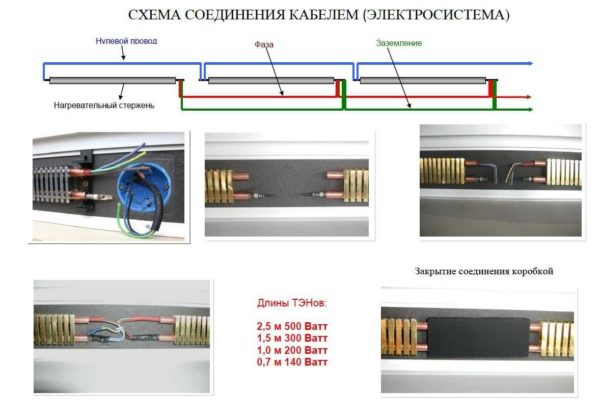
Installation of a heating plinth: you need to know the nuances
Calculation of baseboard heating
A complete heat engineering calculation of heating is a long and complicated matter.
The size and geometry of the room, the material of the walls, floor, ceiling are taken into account, the degree of insulation of all structural elements, including windows and doors, is taken into account. In general, the calculation is not easy.
Therefore, most often they take the average figure, which is derived from the analysis of many calculations.
It is believed that to heat one square meter of the area of a room with an average insulation, 100 W of thermal energy is needed. That is, to calculate the power of a warm plinth, you need to multiply the area of the room by 100. Get the required figure. This is exactly how much (or better, about 20-25% more) all the elements of a warm plinth should add up to.
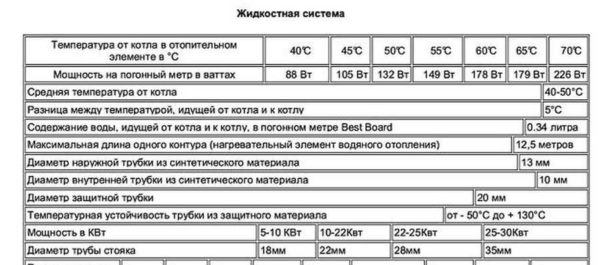

An example of the technical characteristics of the Best Board warm skirting board for different operating modes of the system
For example, the area of a room is 18 square meters. It will need 1800 watts to heat it. Next, we look at how much heat is emitted by one meter of heating. The water heating plinth can work in different modes, depending on the mode, it emits a different amount of heat. The table above shows data for one of the systems. For example, let's take the heat dissipation of one meter of a warm plinth from this table (other manufacturers may have significant differences).
For example, the system will operate with a supply temperature of 50 ° C. Then one running meter produces 132 watts of heat. To heat this room, you will need 1800/132 = 13.6 m of warm plinth. When ordering, it is better to add 20-25% stock. This margin is necessary so that the system does not work all the time at the limit. This time. And also in case of abnormal cold weather. These are two. So, we take 17 meters with a margin.
Once again, we draw your attention: this is the average data for some average house. And even the height of the ceilings is not taken into account here. She again took the average - 2.5 meters. If your insulation is better, you will need less heat, if worse than "average" - more. In general, this method gives only rough estimates.
How to proceed
The first thing to do is to draw a plan on which to designate the length of each heater, the length of the connecting pipes. After all, the length of a warm plinth is not always equal to the perimeter of the room. In this case, the sections of heating devices are interconnected with copper or polymer pipes. It is undesirable to use steel, as they chemically interact with copper (it is gradually destroyed).
Preparation for editing takes place long before its actual start. At the very beginning of the repair, even before the floor is leveled, pipes stretch from the boiler or manifold unit to the connection point of the warm plinth. The pipes are laid, tested for integrity, filled with a screed in a filled state under pressure (working pressure in a private house is 2-3 atm, in a multi-storey house it is necessary to find out in the housing office). Then all the repair work is carried out, and only after finishing the walls and floor, the installation of a warm plinth begins. Here is its order:
- Heat-reflecting tape is attached around the perimeter of the walls. It prevents heat consumption to heat the wall.
An insulating tape is attached, and on top of it fasteners - Fasteners are installed on top of the tape with a pitch of 50-60 cm. They are fixed to the wall using dowels or self-tapping screws (depending on the wall material).
- In the fasteners, according to the plan, sections of the heating plinth are fixed, interconnected with copper or polymer pipes.
Install the pieces and put them together - The tightness of the system is checked by pressure testing.
- If everything is normal, pipes from the manifold unit or from the boiler are connected, the system is filled with coolant and tested.
This is how it looks when it's done - After successful tests, decorative covers are installed and the baseboard heating system is ready for use.
Actually, the installation of warm skirting boards is not too difficult. But the tightness of the joints is important and special attention must be paid to this.
Instructions for assembling the heating system
Installation of a warm skirting board is allowed on almost any surface, including:
- On a wooden one.
- On drywall.
- On concrete foundations.
- On brickwork.
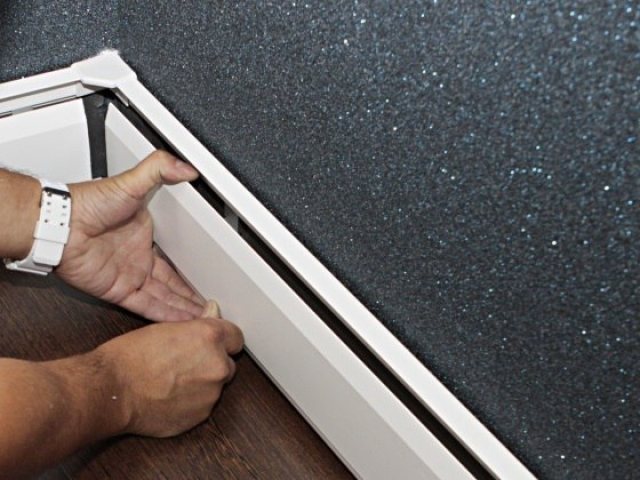

If you mount the device on your own, then perform several preliminary actions and then proceed sequentially:
- You need to decide from the very beginning where all the output points will be located when connecting the system. Under the condition of the permissible thermostat power, an accurate calculation must be made.
- The installation box should be installed no more than five centimeters from the floor covering and this stage is the only one where the help of a specialist will not be superfluous.
- Where the electric skirting board will be mounted, a flame-retardant insulating tape is glued.
- After that, the lower aluminum strip is installed.
- Further along the level, markings are made on the wall, then the panel should be pressed against the wall and the holes for fastening should be marked. After that, the panel is fixed on the dowels and the main module of the device is attached.
- On the clips installed after 40 centimeters, the upper aluminum profile is fastened. After that, the heating element is inserted into the lower tube and the module is secured with clips.
- The walls and insulation material should not be allowed to come into contact with the heating module, and the minimum clearance should be between 4 and 6 mm.
- After that, the heat-shrinkable tube should be additionally insulated. Close everything with a plastic box and put in corner and end pieces.
- All sections are interconnected and a heat-resistant cable is used for joining them. If desired, the cable can be insulated with ducts in the wall.
- After all the structural elements of the warm plinth are installed, it is necessary to measure the insulation resistance and install a thermostat.
- The thermostat is mounted at the same height as the switches and sockets. After installation, the regulator should be closed and immediately checked for relay actuation.
- After that, the entire system needs to be connected to the network and enjoy the comfort of the created free space.
- As for heat exchangers, they should be connected strictly in parallel, and the connection itself is carried out through a junction box or a thermostat.
The device and principle of operation of a warm skirting board
How to make air heating of a private house with your own hands
A warm skirting board is a fairly simple device consisting of an electric module and a natural shell that does not emit extraneous odors when heated.
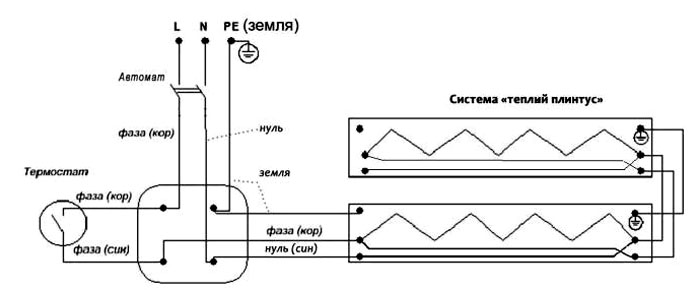

Electric skirting board
What is a warm skirting board? In general, there is no new word of technology in this device. Simply all the same principles of electric heating, only in a new design.
Inside the device there are heat exchangers fixed on copper tubes. The whole feature of this device is its compactness. The whole structure fits into a narrow box about fourteen centimeters high and three centimeters wide. Such heaters are installed around the perimeter of the room and can serve as the main and additional heating means.
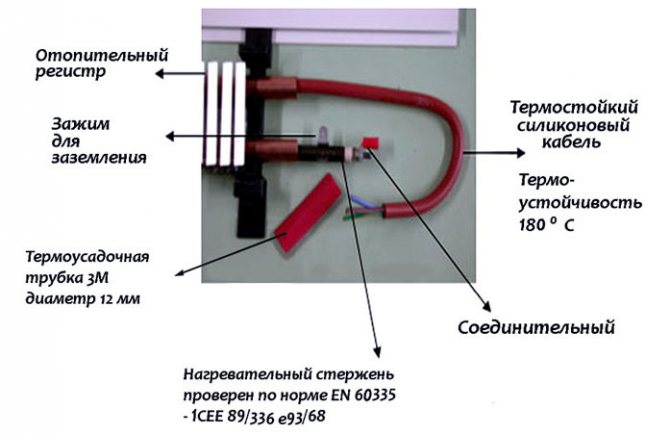

Electric skirting device
Heated skirting board construction:
- convector from tubes;
- box with fasteners for fastening heating elements;
- turning parts.
All these parts of the device are easily assembled into one whole and their installation does not create any problems. The principle of heating a room with this design is also primitive.A heat flow is created along all the walls, which prevents the cold from entering the room. The walls become warm and give off heat energy to the air in the room.
Heating principle with skirting board system
The advantages of the skirting board and its operation
Heating with a warm skirting board literally takes care of human health. This statement can be explained by the fact that in addition to the fact that it performs the main functions in the form of heating the walls and the room, it helps to get rid of excess moisture.
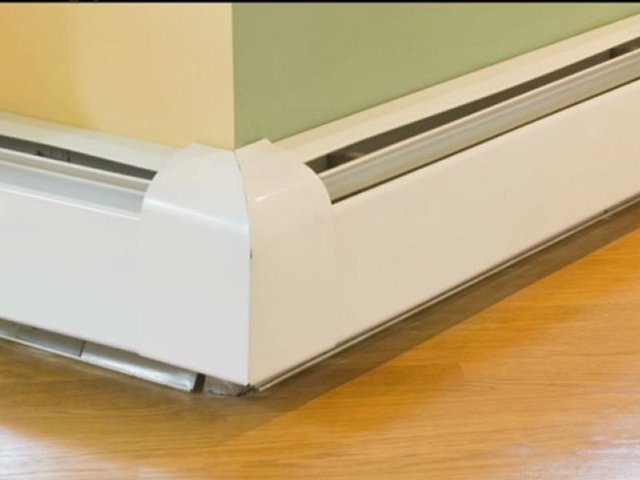

In addition, due to the very slow circulation of air flows, there is practically no additional dust formation, which cannot be said when using standard air heaters and other heaters.
The warm plinth system can be used as the main one in the apartment and if the need arises, for example, when located in rooms such as a loggia or a terrace, it can always be supplemented with familiar heating devices.
Due to the special design of the warm skirting board and the connection via a manifold, the difference between the supply and return temperatures is not a maximum of 5 °. This is 4 times lower than in standard heating systems.
When purchasing a warm skirting board, you will notice not only significant cost savings, but also the free area of the apartment.
As for curtains and furniture that come into contact with the skirting board, you should not be afraid as it has been proven that the system is absolutely safe.
An equally objective advantage is the heating system of a warm skirting board in spacious rooms with a large presence of windows.
Unlike any other heating systems, the warm skirting board does not provide for the possibility of condensation.
Skirting heating
DIY heating from polypropylene pipes in a private house
Despite the fact that in our country what a warm plinth is, it became known not so long ago, in Europe, this method has been used to heat premises for several decades. This technology is very simple, but at the same time it is quite convenient. The basis is made up of metal (most often copper) pipes, they are also a heating element. The pipes are installed in the same place where the plinth usually passes, that is, along the perimeter of the room. Then they are covered with a metal box made of corrugated plates. Due to this design, the box acts as a heat exchanger, thereby increasing the efficiency of the structure.
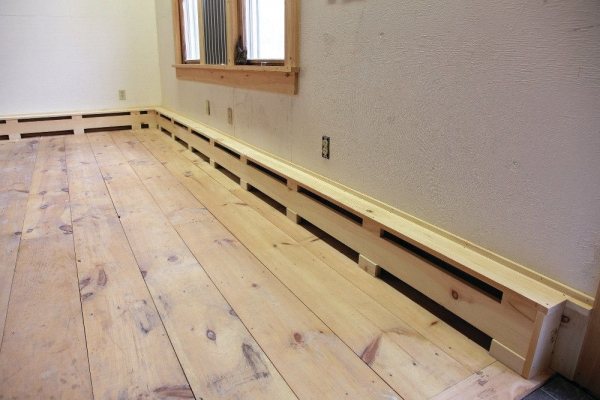

In general, a water skirting board consists of the following elements:
- front panel with holes, due to which the air flow is provided (standard size: width - 3-4 cm, height - 15-20 cm);
- rear panel - facilitates installation of the structure and protects the wall from constant exposure to high temperatures;
- heating radiator that performs the heating function (standard dimensions - 1 mx 0.4 mx 1.6 m);
- swivel side plugs;
- heat exchange module, consisting of two tubes through which water circulates.
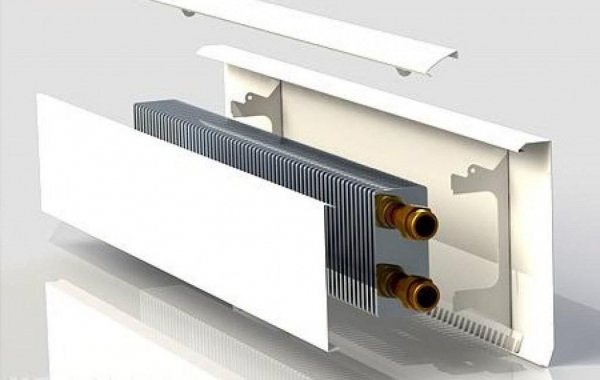

Currently, there is a kind of warm skirting boards (electric.) They differ from water warm skirting boards only in the type of heating element.
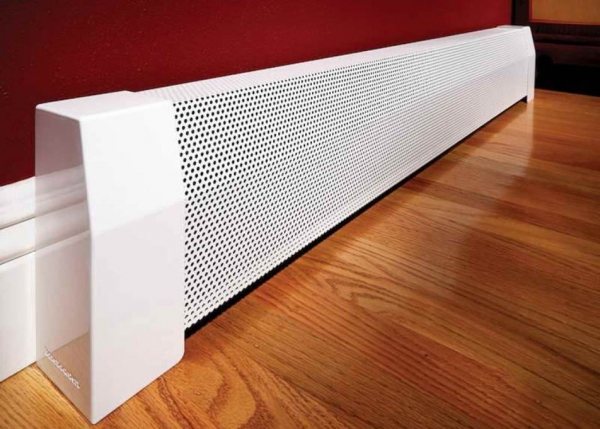

Due to the fact that the plinth is installed around the perimeter of the entire room, the heat gradually rises up, and then the whole room is evenly heated. As a result, temperature drops do not occur with this technology. Since the heating element is hidden under the front panel, it is not noticeable, which favorably distinguishes it from massive ones. As you can see in the photo, the warm skirting board looks very neat, it can be additionally decorated so that it better matches the overall style of the room. The system is efficient but easy to install. With minimal skills, you can carry out the installation without hiring professionals.
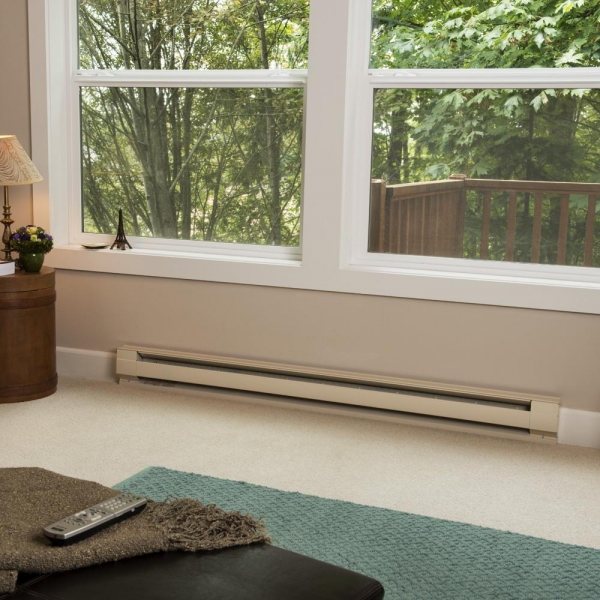

Installation rules
The device itself, an electric skirting board, practically does not differ from any other heating systems and its installation differs only in some features specific to this heating method.
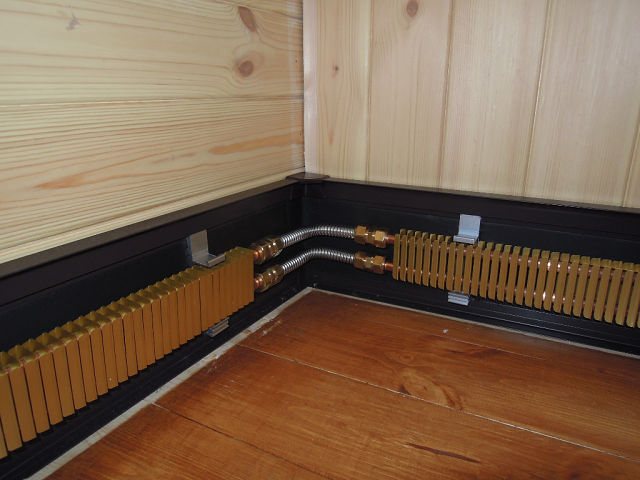

Installation is carried out in several stages:
- First, you need to install a special wall rail with fasteners for heating elements.
- Then you should mount and connect the parts of the heat exchangers into a single complex.
- After that, the plinth should be connected to the heating main.
- Check.
- Cover the device of the warm plinth with a special panel.
As for the rules for carrying out work when installing heating a warm plinth, they are as follows:
- It is undesirable when using the skirting board to be covered by furniture or other objects, since hot air loses its effectiveness. In fact, the heating will not occur in the premises, but in the very furniture.
- Installation of the heating complex must be carried out strictly according to the level.
- It is impossible to install more than 17 sections in a single heating complex. In the case of installation in a large room, each module is connected in parallel and autonomously.
- In order to be safe from power surges, as a result of which the heating system may suffer, it is advisable to install additional fuses and a voltage stabilizer.
How to make a warm skirting board with your own hands
Even Russian-made, this pleasure is not cheap. And what if you want to try such a system, but there is not much "extra" money? Do it yourself. There are two working options.
Option one
Used with a diameter of 12 mm, sheets of roofing copper 0.4 mm thick. The order of work is as follows:
- Cut a strip of roofing copper (60 cm) with a grinder into 15 cm strips.
- Flanging the edges of the strips in their entire length at an angle of 90o and a shelf length of 7-8 mm. The length of the strips is not more than 3 meters - it is inconvenient to work with large pieces.
- Solder copper pipes to the back of this skirting board. This requires solder (plumbing, containing 3% copper) and a torch. While brazing, point the torch at the tube: the strip is thin and will warp if overheated. The tube can withstand heating normally.
- Bend slightly at the ends of the tube before soldering. So it will be more convenient to put on adapters on them.
- For assembly, oil and petrol resistant hoses were used, which can withstand work with a coolant up to 120 oC, (inner diameter 12 mm). At the joints with the pipe, they were fixed with ordinary clamps.
- A manually adjustable thermostat is installed to control the temperature.
- The joints are closed with similar inserts / skirting boards made of copper, but without pipes.
- The panels are attached directly to the wall using standard mounting clips (for pipes). Do not insert them into the recesses - most of the heat is lost.
This system has worked in a wooden house for 9 years. There were no problems or the need for repairs. The temperature of the heating medium at the inlet is from 50 oC to 70 oC. In a room of 20-21 oC, when it rises, it is too hot.
Second option
In this case, for the manufacture of a warm plinth with our own hands, we used aluminum profiles for working with drywall. In them, holes are cut (sawn through) with a grinder from the top and bottom, after which they are attached to the walls. Two copper pipes are laid on a thin aluminum ceiling profile, screwed with aluminum wire. This whole structure is laid inside and fixed to the wall so that the pipes are one above the other. The assembly of pieces of such a homemade plinth was carried out by welding with copper pipes and fittings. "Front panel" - the same profile, only painted with paint for radiators to match the walls (floor). This homemade warm skirting board is less effective, more difficult to clean, but also very workable.
Types of heating skirting boards
The baseboard heating system can be of two types: with electric and water heaters.At the installation stage, a system with warm water skirting boards is more complicated (a collector or beam connection is required), but during operation it is more economical. The electric warm skirting board is mounted quickly - you just need to fix the heaters to the wall, immediately after installation it is ready for use. But heating costs, like any electric heating, are high.
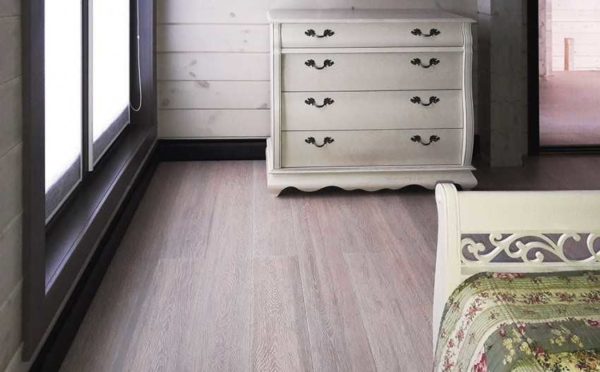

One of the most inconspicuous heating systems is a warm (heating) plinth
Heating device with hot water baseboard
The water baseboard heating system differs only in the non-standard form of heating devices. The key components do not differ from the standard ones: you need a hot water boiler, a manifold assembly and a pipe system with which a warm plinth is connected.
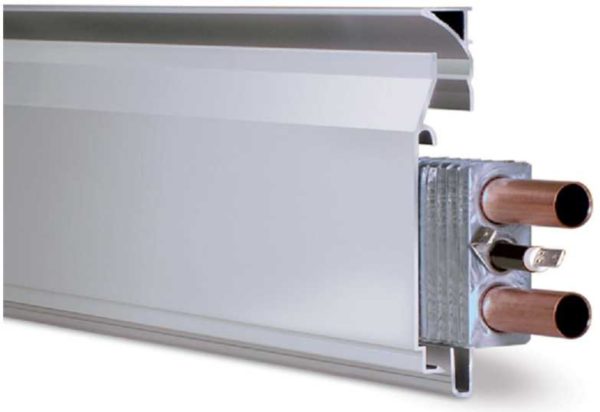

There is also a combined warm skirting board - with an electric heating element and pipes for the coolant
Please note: the optimal operating mode of the system is low-temperature. On the flow 40-50 ° C, on the return about 5 ° C lower
Therefore, it is necessary to select a boiler or build a system based on this. If the boiler is gas, the best choice is condensing. When installing any other, the system requires a heat accumulator and / or a mixing unit to reduce and stabilize the temperature.
Connection method
There are some peculiarities in the choice of the connection method. Serial connection of all baseboard heaters in the room is ineffective: until the coolant reaches the last in the heater branch, it will cool down a lot and they will remain cold almost all the time.
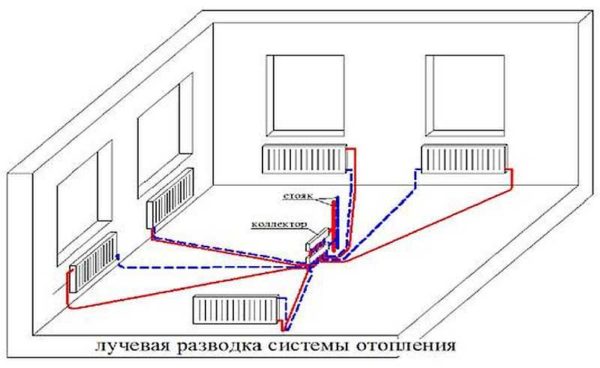

The beam connection diagram looks something like this
For a water heating plinth, a beam system is used: the devices are connected one at a time or in pairs. To do this, a manifold assembly is built into the system, to which pipes are connected that go to heating devices. The disadvantage of such a system is the high consumption of pipes. After all, two pipes go to each device (or a small group) - for supply and return. The pipe consumption is much higher, but the heat distribution is more even and the system itself is more reliable. Why is it more reliable? If pipes or radiators are damaged in one group, all the others work normally.
Installation features
When installing a water baseboard heating, pipes are usually hidden in the floor. Laying them along the walls will not work, since the place is occupied by heating devices. That is, the installation of warm water skirting boards is possible only at the stage of repair - you will have to raise the floors.
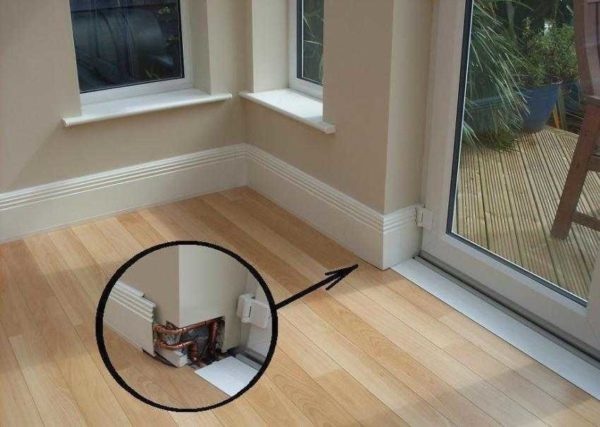

Very attractive when assembled
Special polymer pipes are recommended to be laid in a screed - they are not subject to corrosion and have low heat transfer, that is, heat losses during transportation of the coolant will be small. But since the availability of these systems for repair is not great, it is necessary to take high-quality goods from well-known manufacturers, and this is not cheap.
Electric warm skirting board
An electric warm skirting board externally differs from a water one only in the presence of terminals for connecting power. The rest is the same. These are two tubes with perpendicularly fixed aluminum / brass / copper plates. In the lower tube there is a heating element - heating element, in the upper one they lay wires for connection.
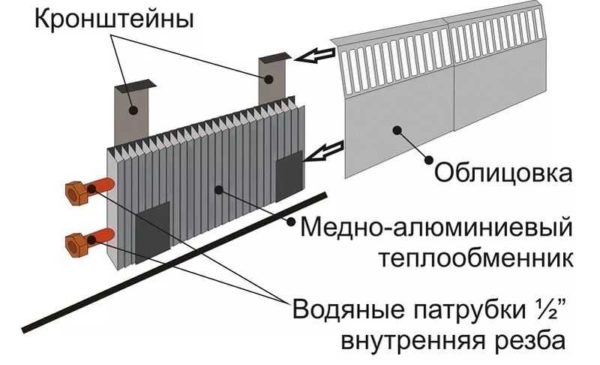

General arrangement of the heating plinth
It is much easier to install and connect an electric warm skirting board. You just need to fix it, stretch the wires and connect them to the terminals. To maintain the set temperature, a thermostat is built into the system, which turns on and off the heaters. The use of thermostats is desirable, as it optimizes operation - it saves electricity.
Installation is really simple, but it is necessary to connect an electric warm plinth to a dedicated line with a properly selected rating of the circuit breaker and copper single-core wires of the appropriate section.So, in this case, repairs are required - it is customary to lay the wiring in the wall, and for this it is necessary to do, that is, to break the walls.
Principle of operation and differences
Baseboard heating manufacturers claim that the system is more economical than all other types of heating. The savings are 20-30%. This is due to the fact that lower temperatures are required to achieve a comfortable feeling. This is because most of the heat is transferred by radiation, and not by convection.
Almost all existing heating systems do not create the best thermal picture: warm air accumulates at the top, cold air remains below. If the room does not have very high ceilings, the situation is tolerable, but in rooms with high heights this is critical. To equalize the temperature picture, forced convection is used: fans are built into the heating devices, which more or less effectively mix the air masses. But the active movement of air carries dust and germs. At the same time, stagnant zones still remain in the corners of the premises, in which cold air accumulates.
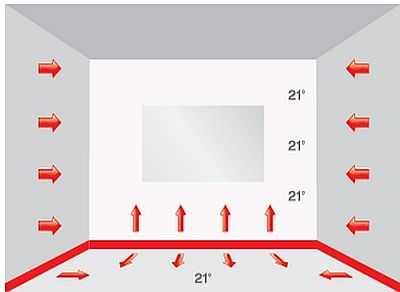

When using baseboard heating, there is no heat cushion at the top, the air is fresh, and the sensations are comfortable
Uneven temperatures and dust in the air are not all the troubles of convection heating. There is also dampness that appears on the walls. The fact is that convection heats up the air. At the same time, the walls remain cold. When warm air and cold walls come into contact, condensation occurs, the walls get wet, fungi and mold develop. Moreover, this picture is typical for houses and apartments with good insulation.
Skirting heating works differently
The first important difference: the lower layers of air immediately heat up, which is already comfortable. Gradually and slowly rising up along the walls, the air cools down, transferring heat to the walls
Therefore, it turns out that the top is not warmer (or not much warmer) than the bottom.
Only about 20-30% of the heat is spent on heating the air by convection. Everything else goes to heating the walls. And this is the second important difference. The heated air rises along the walls, and does not mix with the rest (this effect was noticed by the scientist Coand). Therefore, the rising warm stream cuts off the cold from the walls and heats them up. Yes, as long as the walls heat up and dry, there is a lot of energy (and fuel) consumption. But then the entire surface begins to radiate heat.
This is where the saving zone begins: a person feels comfortable if the temperature of the walls is 36-37oC and the air is 16oC. We simply feel the warmth emanating from the walls with the entire surface of the body. At the same time, the consumption for maintaining the temperature of dry walls is low. Indeed, it is the water contained in the materials that is the best conductor of heat, and the air that replaced it, on the contrary, conducts heat poorly.
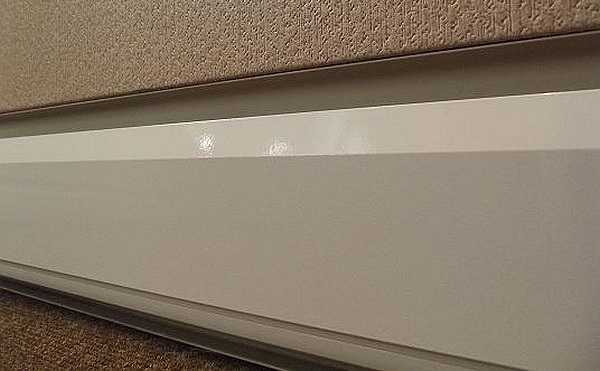

This is what one of the options looks like close up
That is why with such heating it is not so important whether there are pieces of furniture along the walls or not: it is mainly the walls that heats up, not the air. Let them take away some part of the heat, but then they themselves will begin to give it away. And the walls will heat up anyway.
Main advantages
- Optimal space heating. An electric skirting-type convector first of all heats the floor and walls, which begin to emit heat, filling it with exactly the area in which the residents are located, and not the ceiling, as is the case with classic radiators. Also, at the same time, a thermal curtain is formed, which perfectly prevents heat losses through window openings;
- Compactness. Skirting radiators have almost the same dimensions as conventional floor fillets and are installed instead. That is, their presence in the room will not affect the usable area in any way;
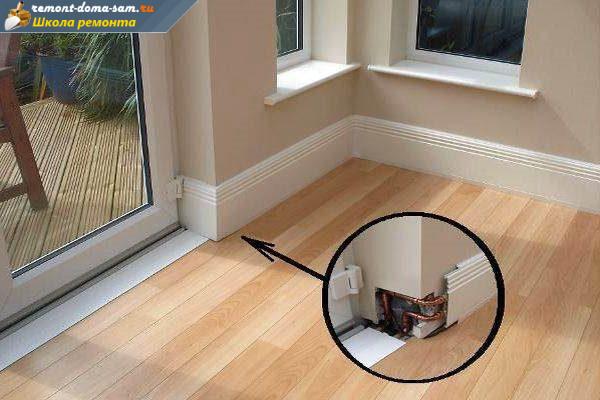

The skirting electric convector does not at all pretend to have a large amount of free space
- Safety. You still need to try to get burned on the heating baguette, since it is located in an area that is not in contact with a person;
- Do-it-yourself ease of installation. The process is not very different from the installation of ordinary fillets, only the electrical part is added, the subtleties of the connection of which we will analyze below;
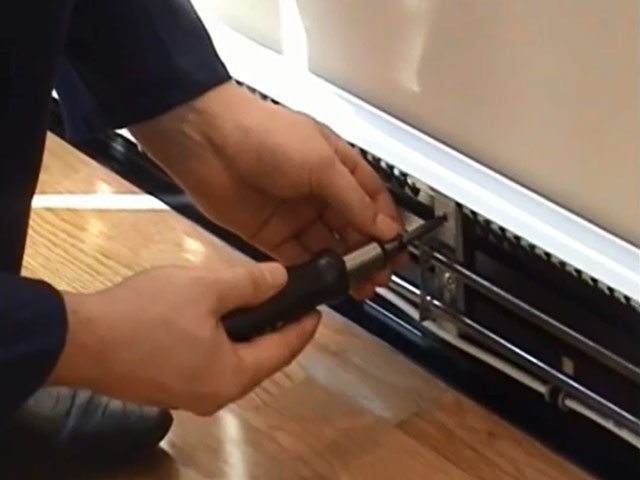

Do-it-yourself electric warm skirting board is easy to install
- Reducing energy costs up to 20-40% due to more rational distribution of heat;
Tip: try to cover the heating panels less with furniture items. This will significantly increase their efficiency.
- Prevention of mold. Dry warm walls are not suitable for the spread of fungi;
Advice: the installation of a thermal skirting board is especially recommended in homes where allergy sufferers live, since the absence of dampness on the walls due to its functioning means a significant reduction in allergens.
- Full automation for ease of operation. You can set a timer or even a cyclic operation of the equipment, which will significantly save you during your absence. It is also allowed to set the maximum temperature for heating the air in the room, after which the unit will turn itself off;
- Nice appearance. The range of models of thermal skirting boards is no less diverse than that of decorative skirting boards. So you can not only create an optimal microclimate in your home, but also decorate its interior;
Stylish heating molding goes well with wood furniture
- Affordable cost. These devices have a very reasonable price, and if we add here the possibility of self-installation and savings on energy consumption, then the financial issue becomes completely irrelevant;
- Possibility of combining with other heating systems. The thermal skirting board will not conflict with water radiators or "warm floors" in any way.
Is the installation of a warm plinth water price per meter justified?
The data from this table will be useful for calculations.
| product name | unit of measurement | Price per meter / piece, rub. |
| Heating element | m. p. | 2010 – 2120 |
| Front Panel | m. p. | 670 – 720 |
| Upper fixing bar | m. p. | 360 – 400 |
| Bottom fastening strip | m. p. | 190 – 230 |
| Heater mounting bracket | PC. | 70 – 90 |
| Inner corner plug | PC. | 70 – 90 |
| Outer corner plug | PC. | 50 – 60 |
| End cap | PC. | 100 – 120 |
| Fitting for straight runs | PC. | 170 – 200 |
| Flexible tube with seals for 90 ° and 180 ° rotation | PC. | 415 – 440 |
To analyze the parameters of a warm water baseboard, the price and reviews should be studied together. The approximate cost of one running meter of the system is 3,600 rubles. To equip a room of 20 sq. M. when installing a plinth only along two walls, you will need to spend 32,400 rubles. The price of standard aluminum radiators for such a room, together with Mayevsky taps and regulators, is about 8,500 rubles. According to the construction forums, ordinary users do not have significant difficulties during installation in both cases.
When painting the outer surface of a water heating plinth in a certain color, to better match the interior, you will have to pay from 900 to 1,400 rubles. for 1 m. p.
Advantages and disadvantages of warm skirting boards
Next, we will consider the pros and cons of warm skirting boards, both water and electric. Let's start with the positives:
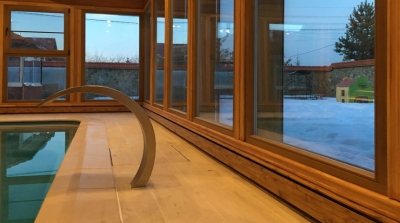

Skirting radiators are an excellent choice for rooms with panoramic windows.
- The diminutiveness of the equipment is perhaps the most important advantage characteristic of any warm skirting boards, including electric ones. Thanks to this, we have the opportunity to get at our disposal an extremely compact heating system that is not striking;
- The possibility of heating rooms with panoramic windows - warm skirting boards will provide reliable protection against cold air currents and prevent condensation;
- Low body temperature - as a rule, it does not exceed +40 degrees, so that accidental contact with baseboard radiators does not lead to burns;
- Uniform heating of air masses throughout the volume - you will not feel discomfort and feelings of freezing feet;
- Warm skirting boards (including electric ones) are suitable for use in any premises - these are kitchens, living rooms, bedrooms, corridors, loggias, covered balconies, terraces, retail premises, entrance groups, halls and much more;
- Possibility of simultaneous work with any other heating devices. For example, electric convectors can be used in conjunction with electric warm skirting boards, and classic batteries are often mounted together with water appliances.
There are also some disadvantages:
There are some difficulties when installing warm skirting boards in a room with built-in furniture.
- The high cost of warm skirting boards is typical for any equipment, including electrical;
- Lack of efficiency - many manufacturers claim that skirting heating allows you to save money, but these statements can be questioned;
- High power consumption is typical for electrical models. Even if rural tariffs are in effect in your area, the costs will be very high;
- Warm skirting boards cannot be laid where built-in furniture is installed - it closes the space required for equipment installation.
However, baseboard heating continues to grow in popularity. Where not so long ago there were bulky cast-iron batteries, today extremely compact warm skirting boards appear - electric and water. Thanks to a well-thought-out design, they provide quick and uniform heating of the premises, giving people warmth.
Electric warm skirting board: design features
Despite the fact that it was possible to buy a warm electric skirting board in the western market already 20 years ago, it is still a novelty for the Russian consumer. And surprisingly, it did not immediately become very popular, despite the convenience and economy of use, since few were ready to abandon traditional heating systems. In fact, it is one of the most efficient heating devices that can be found today.
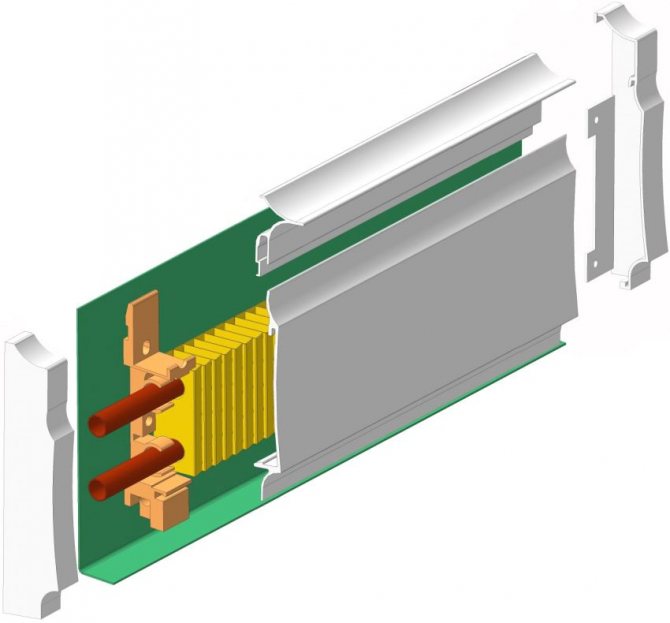

Electric warm skirting board construction
It is worth noting that there is not only electric, but also water warm skirting board, which also has certain advantages. But speaking about the use in country houses of our country, as a rule, preference is given to electric models, since this is the only type of energy supply available almost everywhere.
It happens that heating is carried out with the help of liquid or solid fuel. However, this option can hardly be called economically viable, and the effort required for fuel storage and equipment maintenance is much greater. It is much easier to use electricity as a source of energy, especially since the installation of such a system is not particularly difficult.
Regardless of whether it is an electric or a water appliance, outwardly they have the same design: an aluminum strip, the width of which is 3 cm.At the same time, its height can be very different, from 10 to 24 cm.The color and shape can also be what whatever.
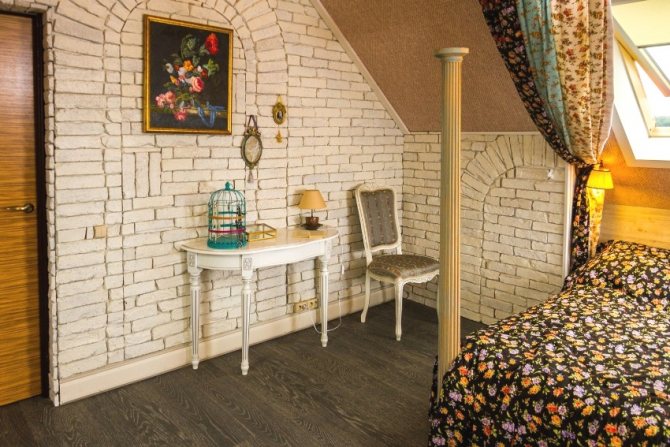

Warm electric skirting board in the bedroom of the attic floor
The main difference between an electric device and a water one lies inside. If in the second case we are talking about a tubular structure, on top of which ribs are planted, then an electric plinth is a standard heating element or a tubular electric heater.Having a rather long tube length that occupies the entire internal space of the heater, it perfectly provides the room with heat.
It is also important that a special heat-resistant alloy is used for the manufacture of such heaters, which provides an incredibly long operational life of the device.
The working principle of a warm electric skirting board
According to the principle of operation, the electric skirting board is practically no different from the underfloor heating system, which are often used in private houses. That is, in addition to the heating element, there is also a thermostat, which is responsible for adjusting the set temperature regime.
Connection diagram of heating elements: blue - zero, black - phase, yellow - ground
Temperature control, in turn, is the responsibility of temperature sensors, which are mounted on the wall (slightly above the middle of an adult's height). You can connect such a plinth to a regular outlet, however, according to experts, it is better to use a separate cable branch for this purpose, leading it from the switchboard and additionally installing an automatic machine on it.
The choice of thermostats that the modern market is ready to offer to the buyer is more than great. And here it is worth focusing on both the functionality of the device and its cost. Of course, the price of the most multifunctional and complex devices will be much higher than that of simple models.
The most popular are those models that perform all the necessary tasks automatically, without human intervention. Many automated systems of this type allow not only setting the desired temperature, but also pre-programming modes for several days in advance.
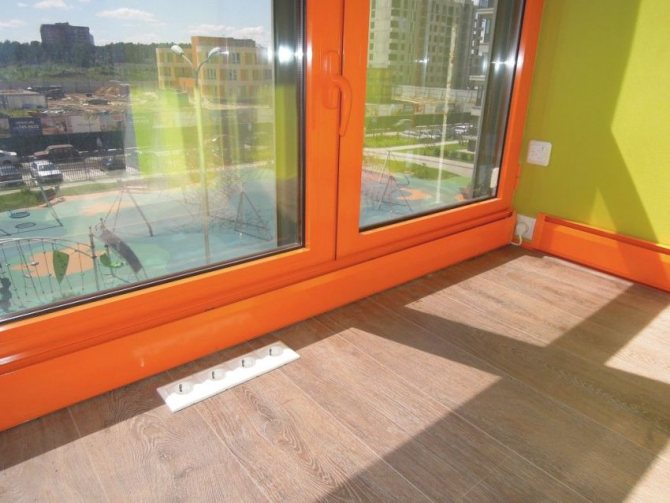

Warm skirting board is an ideal solution for installation in a room with panoramic windows
The main advantages of warm skirting boards
The operation of a warm electric skirting board is based on several basic principles, which are at the same time the advantages of such a system:
- The electric skirting board is attached to the wall along the entire perimeter of the room at the traditional installation location of this decorative element.
- When heated, such a heating device gives off heat not only to the air in the room, but also directly to the walls with which it comes into contact. Thus, heat loss is significantly reduced.
- The heat energy from the skirting board is distributed evenly from the floor to the ceiling. This happens by reducing the convection of air masses in the room.
- The warm air slowly rising from the baseboard does not raise dust from the floor, which also plays a significant role.
- The skirting board temperature can be adjusted between 40 and 70 ° C. Thus, you can select the most comfortable temperature regime for the weather that is typical for a particular season or day.
According to users, when using such a heating element, the temperature in the room will definitely not drop below 20 ° C, and this can be considered a comfortable living environment.
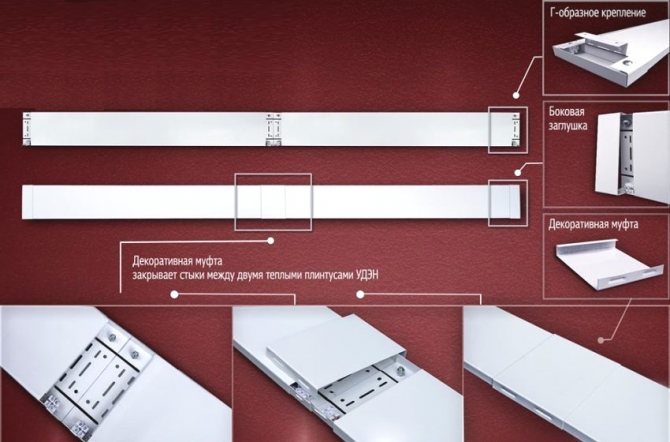

The construction of a warm skirting board using the example of UDEN products
Another important point - in comparison with other electric heaters, skirting boards consume significantly less electricity. According to the figures, to produce the same amount of heat, the baseboard requires 30% less energy than a conventional heater. And this is a significant savings if the heating is turned on throughout the day.
An important question that buyers often ask before purchasing a warm skirting board is whether there are any restrictions on the installation of such an element. In fact, there are no actual limits. You can install such skirting boards in absolutely any room. And as for the correspondence of this decorative element to the interior, the choice here is so great that you can easily find the right option.
Helpful advice! Warm skirting boards are an ideal solution for rooms with panoramic glazing, because it is impossible to install standard radiators under such windows, but an electric skirting board will easily solve this problem, and at the same time complement the interior.
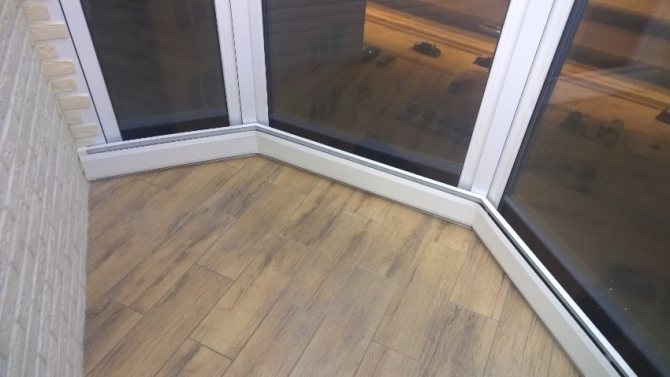

Warm plinth as heating on a glazed loggia
Choosing a skirting infrared heater
In order not to be mistaken with the choice of an electric skirting convector, you first need to get acquainted with the existing varieties. The most popular devices both in Moscow and in other cities are infrared devices. Such designs have an operating power of no more than 150 watts. They can be used as the main heating method, since they are able to generate 5 times more heat than similar appliances.
The design of such a system includes anodized aluminum lamellas, due to which strong heating of walls and nearby surfaces is ensured. Due to the installation of such skirting boards, an effective curtain is created, which perfectly protects the room from cold air.
Cable heater device
Skirting boards of this type can be used to heat any room, except for those where high humidity prevails. The advantage of these heating systems is a more simplified assembly scheme. Heating elements are mounted in a box, while installing a manifold and laying supply lines is not required.
The principle of operation of the skirting convector
During the operation of the heating skirting boards, maintaining a comfortable temperature in the room is ensured not only by influencing the air in the lower part of the room, but also by transferring heat to the wall surfaces. In order to heat the air by convection, it is necessary to spend about 30% of all energy, and the rest of it is spent on heating the walls.
After the air warms up to the required temperature, it begins to rise up along the walls, where it mixes with warmer air currents. The result is an air cushion. After the walls warm up to a temperature of 37 degrees, they begin to release the received heat into the space of the room.
When choosing the best option for a warm skirting board, you need to pay attention to its price. The cost of such a system may vary.
Much depends on the features of the device and the characteristics of a particular model. The skirting board has a heating element covered with a light metal strip. This element includes copper pipes, to which the radiator fins are connected.
Installation features
efficiently
Installation of the Megador warm skirting board is carried out in two stages. It all starts with preparing the terminals for connecting the structure, then the supply lines are laid and the cable is connected.
The second stage begins only after finishing the premises. When using a water-type heating plinth, first, all its elements are installed, the modules are connected to the outgoing elements, after which the circuits are set up and the system is pressurized. In the case of an electric warm skirting board, first you need to install all the elements of the case, connect to the terminals of the circuits, and then measure the insulation. The final step is to set up the thermostat.
Particular attention should be paid to calculating the number of sections, where it is important to avoid mistakes. Here you need to pay attention to the power of the system and possible heat loss.
The final figures will differ in each case. It all depends on the quality of insulation of walls, window structures and air temperature. I would like to draw your attention to the fact that when using an electric type of skirting boards on an area of 10 m2, 0.5 kW is required. If the water option was chosen, then this figure is doubled.
Device
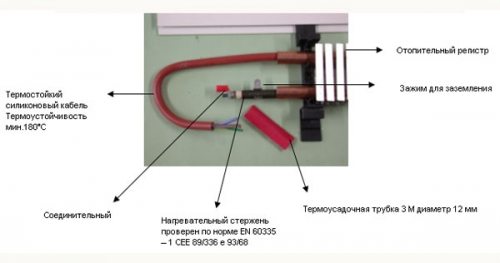

Thermoplint construction
A heating electric skirting board is a special floor fillet made of aluminum or other suitable material, equipped with heating elements inside, made on the basis of heating elements. Such a device is connected to a conventional 220 V outlet and carries out both convection and thermal radiation.
Infrared heating elements can also be used. Their price is somewhat more expensive, but they take up even less space.
Infrared electric warm skirting board is very compact
Principle of operation
The movement of heat when heating a room with a thermal skirting board
Electric warm skirting boards heat primarily the walls to which they are attached. Warm air slowly rises up through them, due to which an effective heat curtain is formed around the entire perimeter of the room, preventing the penetration of cold inside. Then the cooling masses go down, warming the floor in the center of the room, and again fall into the field of activity of the heating elements.
Advice: it is especially advantageous to install electric skirting board heating in damp rooms, as it will dry the walls, which will prevent them from rotting and the appearance of mold.
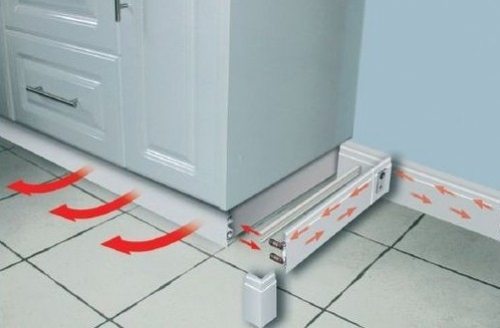

Kitchen walls will be dry and warm if heating fillets are installed
Technical specifications
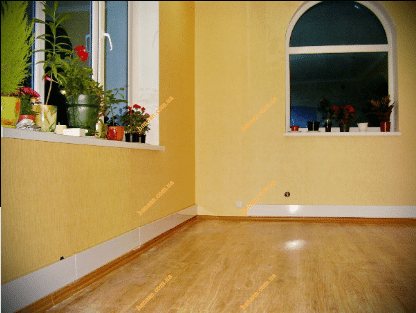

Heating electric skirting board "UDEN-200 Standart"
Let's consider the main operational characteristics using the example of the UDEN-200 Standart model:
| Characteristic | Value |
| Power consumption | 190-210 watts |
| Required power supply | 220 V |
| Radiation covered area | 0.14 m2 |
| The volume of the serviced premises | 9-12 m3 |
| Heated area with a ceiling height of 250 cm | 3.7-4.7 m2 |
| Surface heating | About 80 degrees Celsius |
| Weight | 3.5 kg |
And the linear parameters of the device:
| Linear parameter | Value, mm |
| Length | 975 |
| Height | 130 |
| Depth | 35 |
As you can see, the panels are rather small and fit perfectly instead of ordinary floor moldings.

